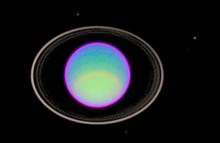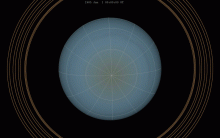Listen to today's episode of StarDate on the web the same day it airs in high-quality streaming audio without any extra ads or announcements. Choose a $8 one-month pass, or listen every day for a year for just $30.
You are here
Uranus at Opposition
A second planet is at its best this month. Mars was at its peak a couple of weeks ago, and is still shining brightly. And today, Uranus is at its peak. But while it’s a lot bigger than Mars, it’s also a lot farther away, so it isn’t nearly as bright. You need binoculars to pick it out.
Uranus is the third-largest planet in the solar system — about four times the diameter of Earth. In the odd jargon of science, it’s known as an ice giant.
That’s because most of the planet probably consists of a deep layer of water, ammonia, and methane — compounds that are classified as ices. On Uranus, though, they’re not what most of us would think of as ice — they form a hot, dense fluid.
The planet probably has a small, heavy core below the ices, and a thin layer of hydrogen and helium above them. The water and other compounds form clouds at the top of the atmosphere. Methane clouds absorb red light, so only bluer wavelengths pass through. That gives Uranus a blue-green color. It’s pale, though, because the planet’s average distance is 1.8 billion miles — making it a hard-to-see giant.
This is a good time to look for Uranus, though, because it lines up opposite the Sun. It’s in the sky all night, and it’s brightest for the year, too. Tonight, it’s due east at nightfall, above the Moon. It’s tough to see through the lunar glare. It’ll be a better target in a few days, when the Moon gives it a little more space.
More tomorrow.
Script by Damond Benningfield





